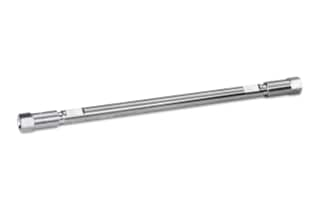
|
Chemistry |
C18 |
|
Separation Mode |
Reversed Phase |
|
Particle Substrate |
Silica |
|
pH Range Min |
3 pH |
|
pH Range Max |
7 pH |
|
Maximum Pressure |
6000 psi (415 Bar) |
|
Endcapped |
Yes |
|
Bonding Technology |
dC18 |
|
Silanol Activity |
Medium |
|
Particle Shape |
Spherical |
|
Particle Size |
3 µm |
|
Endfitting Type |
Waters |
|
Pore Size |
100 Å |
|
Format |
Column |
|
Surface Area |
330 |
|
System |
HPLC |
|
USP Classification |
L1 |
|
Inner Diameter |
3.9 mm |
|
Length |
150 mm |
|
Carbon Load |
12 % |
|
UNSPSC |
41115709 |
|
Brand |
Atlantis |
|
Product Type |
Columns |
|
Units per Package |
1 pk |

Atlantis dC18 Column, 100Å, 3 µm, 3.9 mm X 150 mm, 1/pk
After a two-year stationary phase creation project, Waters was able to develop a reversed-phase HPLC column specifically for the retention and separation of polar, water-soluble compounds. By focusing on a new and unique stationary phase packing material, the silica-based di-functionally bonded C18 material in Atlantis dC18 Columns was developed. These columns include optimized versions of stationary phase physical attributes, including end-capping, silica pore size, bonded phase ligand density, and ligand type. This means these columns offer superior peak shape, low pH stability, resistance to dewetting, and enhanced polar compound retention.
In addition to retaining polar compounds, Atlanta dC18 Columns provide excellent peak shape for compounds and are fully LC/MS-compatible, combining all the desirable characteristics of an ideal reversed-phase HPLC column. These columns are suitable for separating polar compounds as well as standard reversed-phase applications. The fully end-capped nature of Atlantis dC18 columns allows for superior peak shapes in bases to be achieved with this lab equipment. Lifetimes can be extended using an Atlantis Silica dC18 VanGuard Cartridge, 100Å, 3 µm, 3.9 mm X 5 mm, 3/pk.
When working with polar compound retention, conventional C18 columns require either a mobile phase that contains less organic modifier or using a shallower gradient. In addition to the risk of dewetting, increased or non-polar compound retention often occurs, resulting in co-eluting peaks and making method transfer difficult. The optimal ligand density used in Atlantis dC18 Columns exhibits strong retention of polar compounds without the excessive retention of non-polar compounds. Since polar and non-polar compounds can both be easily separated on one column, this makes Atlanta dC18 Columns close to the idea of an ideal reversed-phase HPLC column.
What Are The Benefits Of A Fully End-capped Column?
Conventional high coverage C18 columns can be made compatible with aqueous mobile phases by omitting the end-capping step of the stationary phase synthesis. An un-end-capped stationary phase can produce severe peak tailing for amine-containing bases. In this case, acetonitrile or methanol must then be added to the mobile phase to improve the peak shapes, which can lead to shortened retention times for acidic and neutral polar compounds. In a fully end-capped column, such as the Atlantis dC18 Column, this tailing and extreme retention for amine-containing bases are avoided.